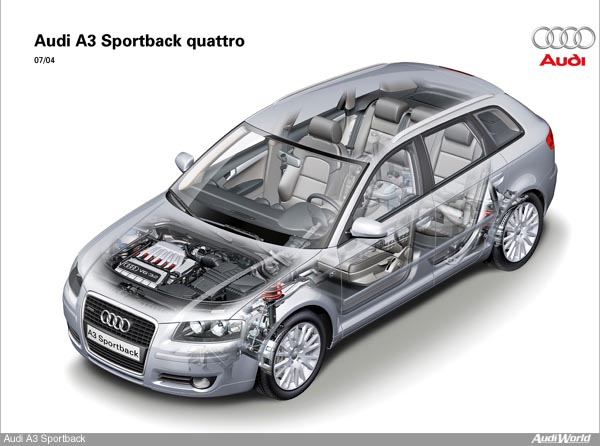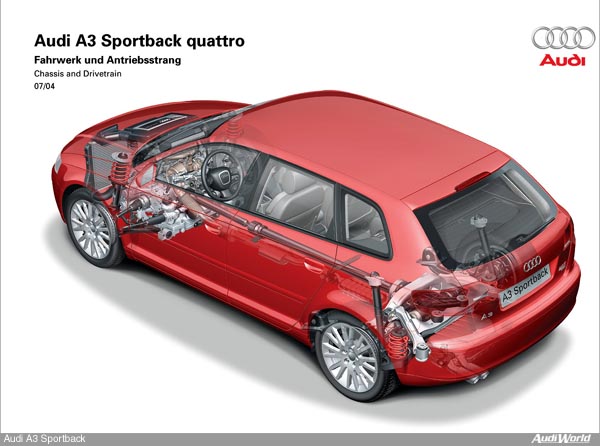The Audi A3 Sportback: Running Gear

The second key to the new Audi A3 Sportback’s excellent dynamics on the road is its highly effective suspension with McPherson strut layout at the front and the new four-link independent suspension at the rear. The dynamic suspension is designed for sporty, agile handling with a high standard of stability, and providing very good handling in bends with both front-wheel and quattro drive. An additional forte is the high standard of ride comfort, as befits a car in a segment further up the range. 16 or 17-inch wheels (17-inch wheels are standard on the Ambition models) enhance the car’s performance on the road and add a clear sporting touch. 18-inch wheels by quattro GmbH are available as an option. The performance of the engines is reflected by the equally powerful brake system with large-diameter brake discs. The electromechanical steering with speed-dependent power assistance is one of the keys to optimum handling. It combines optimum steering feedback with minimal sensitivity to excitation from the road surface, and operates on far less energy. Driving dynamics and superior comfort all in one The dynamic character of the Audi A3 Sportback is palpable. It is manifested not simply by the precise directional stability that benefits from the longer wheelbase. The Sportback also provides a compelling steering response, the initial subjective impression being confirmed immediately by its exemplary precision in following every movement of the steering wheel, every bend in the road. The Sportback comes across as easy to handle, agile and highly responsive on bends. Throughout all of these manoeuvring processes, any movement of the car’s body remains strictly within limits even on bumpy roads and in bends, and does not influence the car’s driving characteristics. The self-steering behaviour remains neutral right up to a very high handling limit, which signals itself to the driver through slight understeering. The driving characteristic is thus overtly dynamic, but nevertheless accompanied by a high degree of comfort. The Audi A3 Sportback’s suspension responds discriminatingly, absorbing surface impact at any speed. The steering, too, remains unerringly calm even on bumpy surfaces, consistently providing a good feel for and contact with the road. The rear suspension The rear suspension critically determines the dynamic driving characteristics and stability of a vehicle. To achieve an even more pronounced sports character, the developers decided to adopt a new axle design for the current A3 generation. They opted for the four-link principle, which combines the benefits of compactness, low weight and above all superior handling. The particular strengths of the four-link suspension layout stem from the functional separation of longitudinal and transverse forces. This provides a high standard of lateral rigidity in the interests of optimum dynamics and driving safety and, at the same time, makes the suspension relatively soft lengthwise in order to improve the standard of ride comfort. On each side the suspension incorporates a wheel carrier with a wheel bearing unit, two lower wishbones (spring link and tie rod), one upper wishbone and a trailing arm. The three wishbones are connected to the car body by a subframe. This structure on the front-wheel-drive A3 Sportback is made of extra-strong steel tubes and plates and is bolted firmly to the body, forming a complete unit that helps to save weight, while simultaneously reinforcing the rear end of the car. The rear axle subframe on quattro models serves additionally to accommodate the final drive and is made of aluminium for even further weight reduction. Separate springs and shock absorbers provide the necessary vertical support. The twin-tube gas-filled shock absorbers are fitted very close to the wheels, permitting a particularly generous through-loading width in the luggage compartment. The anti-roll bar is mounted on extra-firm rubber/metal mounts fitted to the axle subframe, efficiently reducing body sway and helping to improve the transmission of lateral forces and, accordingly, the handling of the car.
The front suspension An extensively acclaimed layout principle has been used for the front suspension: McPherson front axle with triangular lower wishbones. Here, the subframe is bolted to the forward structure. The anti-roll bar is mounted directly on the spring strut. The correspondingly more direct transmission results in greater responsiveness, with the result that the anti-roll bar itself can be kept more compact. This allows the weight of the front suspension to be cut by a further The kinematic configuration of the front axle, in conjunction with the design and configuration of the rubber mounts, helps to produce neutral handling, with slight, always predictable understeering not occurring until the car reaches its limit of handling. The front wishbone mount is extra-firm, to provide good lateral support. The rear wishbone mount, in turn, has a non-linear characteristic, assuring very good ride comfort under minor loads and controlled self-steering behaviour as forces increase. The steering There are many impressive advantages to the electromechanical steering: unlike conventional power steering systems, it only consumes energy when steering actions are actually being performed. This means a fuel saving of up to 0.2 litres per 100 kilometres, depending on driving conditions. Sensors monitor steering forces and the speed at which the driver is turning the steering wheel, applying this data to calculate the power assistance required, which is then built up by an electric motor and transmitted via worm gearing directly to the pinion in the steering system. Another crucial factor in determining the level of servo assistance is the speed at which the car is travelling. In practice this means maximum ease of steering when parking the car, with the driver then registering a more sensitive response and active steering feel as road speed increases. The system also makes it possible to dampen bumps from the road surface effectively. Another innovation is the active return travel of the steering with intuitive zero point. Lateral incline in road surfaces and constant side winds thus no longer impair the vehicle’s directional stability. Brakes and wheels The brake system of the Audi A3 Sportback is a match for the vehicle’s dynamic talents. Four disc brakes, of varying sizes depending on the engine version, provide safe, dependable deceleration. The top-of-the-range 3.2 quattro even comes with a 17-inch brake system that sets a new standard in this segment. On the front brakes this means a disc diameter of no less than 345 millimetres. The Audi A3 Sportback is also the pioneer in its class when it comes to operation of the brakes. The compact premium sports car has the feature introduced latterly on the Audi S4 of a dual-rate brake servo. In normal conditions, it allows the braking force to be dispensed very responsively, with an amplification rate of 1:5. When the driver applies the brakes in an emergency, however, the brake servo, on sensing a pre-defined braking pressure, switches to a higher support factor of 1:8.5. An Electronic Stabilisation Program of the latest generation, ESP, assures active safety reserves at all times. This control system incorporates the anti-lock braking system ABS, electronic brake-force distribution EBD, the traction control system ASR and the engine drag torque control system MSR, the electronic differential lock EDL, hydraulic brake assist and the extended stability braking system ESBS. The enhanced control algorithm in the electronic control unit now enables ESP to recognise potentially critical situations at an even earlier point in time, intervening preventively whenever necessary. With its self-learning capacity, ESP consistently monitors the car even in stable driving conditions, thus constantly adjusting the intervention point to the current driving situation on the road. This benefits both safety and ride comfort. ESP can intervene much earlier in critical situations and, on the other hand, prevents unnecessary actions. The Attraction and Ambiente versions of the Sportback come as standard with 16 inch wheels running on 205/55 R 16 tyres. The Ambiente models have cast aluminium wheel. The ultra-sporty Ambition Sportback versions are equipped with sports suspension and 17-inch cast aluminium wheels with 225/45 tyres. This combination not only looks stunningly dynamic, but also offers excellent running qualities on both dry and wet roads. |

